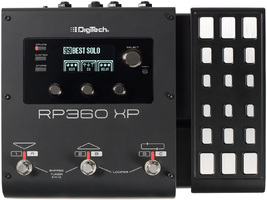
The Huntersounds RP360 Patch Set Is Getting Close
I’ve been steadily working towards the release of my patch set for the Digitech RP360/RP360XP, and we’re pretty close to go. There will be a few changes in this set versus previous sets:

I’ve bitched a lot about the uselessness of Digitech’s Nexus application for editing the RP, and I still have my problems with it. However, it’s actually pretty useful if you do initial patch editing from the RP360’s front panel, and use Nexus for the finishing touches, like balancing the relative levels of patches and assigning the footswitches to particular patch parameters for Stomp mode. The former is accomplished with a slider in the software, and the latter by dragging and dropping the effect you want to control into a slot representing the footswitch. Fast and tidy. For people who don’t change patches frequently in the middle of a song, Stomp mode looks like the way to go. If you do like to change patches in the middle of a song, Stomp mode isn’t ideal, because the footswitches in Stomp mode turn FX on or off, and you can’t use them to change patches in that case. (You can still change patches by rotating the large dial on the front panel, but that’s not ideal when you’re in the middle of a performance.)
My RP360/360XP patch set will retail for $50, and it’s my best work to date. I’ll be updating my RP500 and RP1000 patch sets, in that order, with the refinements I’ve made for the 360, so if you’re using one of those devices, stay tuned–that’ll be a free upgrade for current RP500 and RP1000 patch set licensees. In the meantime, give me a few weeks–to mid-May 2014–and the 360 patch set will be lighting up your RP.
Related Posts
2 Comments
Leave a Reply
You must be logged in to post a comment.
WHAT’S NEW
Categories
- Audio/Video
- Blog
- Blue Future
- Digitech RP Tricks and Tips
- Discography, CDs, Projects, Info, Notes
- Featured Video
- For the Beginner
- Gallery
- Hunter's Effects
- Hunter's Music
- Huntersounds for Fender Mustang
- Meet the Pros
- More Video
- MPH: Maw/Preston/Hunter
- My Three Big Contributions
- Player's Resources
- Pro Tips & Techniques
- Recommended Artists & Recordings
- Recommended Gear
- Recorded Performances
- Reviews, Interviews, Testimonials
- The Lucky One
- Uncategorized
- Upcoming Performances
- Zoom G3 Tips and Tricks
Hello
I have a rp360 and was wondering how i can save my user presets and how to reinstall them.
I’m considering doing a firmware update, so wanted to make sure i could reinstall my
user presets. Any info you can provide will be appreciated.
thanks
@Carl: start by downloading and installing the Nexus application from digitech.com. Then use the BACKUP function (in the upper right corner of the Nexus screen) to save all your presets in one shot. You can use the RESTORE function to put all the presets back on the RP when you’re ready. If you’d rather go preset-by-preset (why? I dunno–maybe you just do) then use the “import” and “export” functions–export to save a preset, import to load it into Nexus (and from there to your RP). Did I mention that you can back up the whole shebang at once via BACKUP? I’m just sayin’.